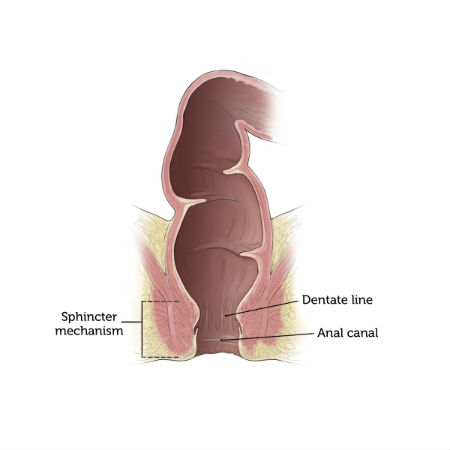What is a Hirschsprung's disease pull-through procedure?
In children with Hirschsprung's disease, the intestinal nerve cells (ganglion cells) don't develop properly. This delays the progression of stool through the intestines. As a result, the intestine becomes blocked with stool, and your baby or child will be constipated (unable to have normal bowel movements).
To fix intestinal obstruction caused by Hirschsprung's disease, surgeons at Boston Children's Hospital perform a type of surgery called a pull-through procedure. The goal of pull-through surgery is to remove the diseased section of your child's intestine and then pull the healthy portion of this organ down to the anus. In most cases, this procedure can be done with minimally invasive techniques in a single operation.
In children with Hirschsprung's disease, the intestinal nerve cells (ganglion cells) don't develop properly. This delays the progression of stool through the intestines. As a result, the intestine becomes blocked with stool, and your baby or child will be constipated (unable to have normal bowel movements).
To fix intestinal obstruction caused by Hirschsprung's disease, surgeons at Boston Children's Hospital perform a type of surgery called a pull-through procedure. The goal of pull-through surgery is to remove the diseased section of your child's intestine and then pull the healthy portion of this organ down to the anus. In most cases, this procedure can be done with minimally invasive techniques in a single operation.
How we perform the pull-through procedure for Hirschsprung's disease
Surgeons typically perform the pull-through procedure when a child is initially diagnosed with Hirschsprung's disease. The physician will first take one or more tissue samples (biopsy) of your child's bowels to identify the areas of the intestine that lack ganglion cells. The surgeon will then remove these sections of diseased intestine, either through a large incision in your child's abdomen (open surgery) or by inserting a thin, lighted tube with a camera on it (laparoscope) through a smaller incision. In some cases, the pull-through procedure can be performed entirely through the child's anus, which doesn't leave any scars.
After removing the portion of intestine affected by Hirschsprung's disease, the surgeon will then attach the end of the remaining, healthy intestine to the child's anus. Because this part of the intestine has working nerve cells, your child should be able to pass stool normally after recovering from the procedure.
It's not uncommon for children who undergo the pull-through procedure to continue to experience constipation afterward. In addition to a balanced diet, we may recommend laxatives or other medications to help regulate bowel function. Because your child will need to learn how to control the muscles in the rectum and anus to go to the bathroom properly, we may also suggest that they follow a bowel management program.

A normal, healthy bowel following the pull-though procedure
Pull-Through Procedure | Programs & Services
Programs
Colorectal and Pelvic Malformation Center
Program
The Colorectal and Pelvic Malformation Center cares for children with routine to complex colorectal and pelvic conditions.


